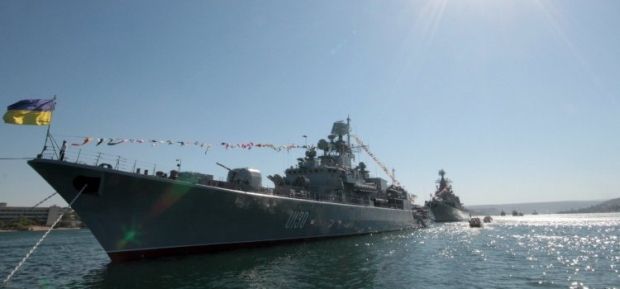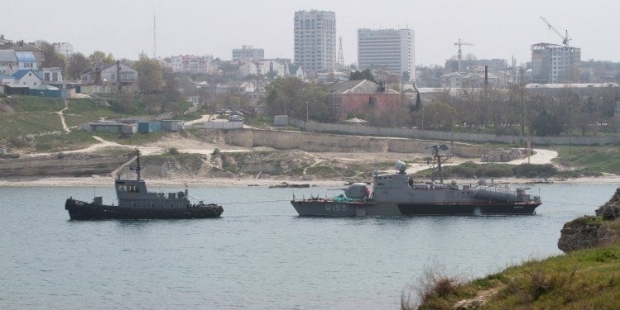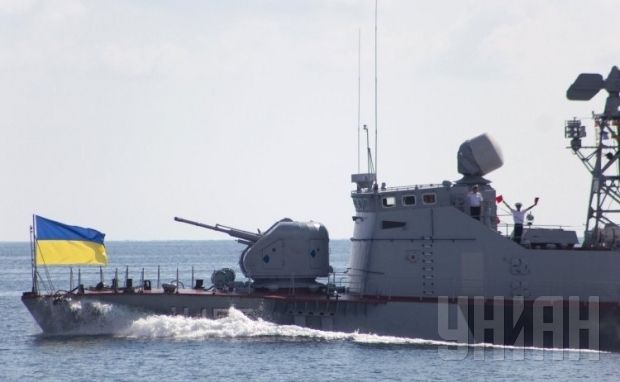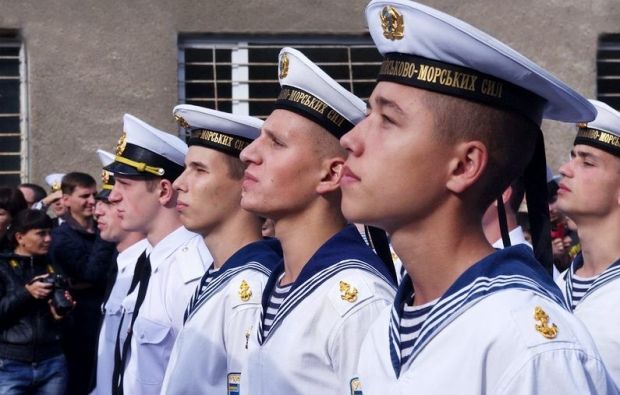
Deputy chief of Ukraine’s Navy: terms of operation of all Ukrainian military vessels will have run out by 2018
Andriy Ryzhenko, deputy chief of staff of the Ukrainian Navy tells UNIAN, whether Ukraine will remain a submarine power, what our Navy will be like, how much it will cost and where to get the money.
The Navy is an important part of national security and defense. And our "crazed" neighbor, who has long been massing up its fleet in Ukrainian Crimea (which it later annexed), makes us review the concept of military fleet development. Captian Andriy Ryzhenko, deputy chief of staff of the Navy Command of the Armed Forces of Ukraine on European Integration, talks about the prospects of implementing the strategy of the State maritime doctrine, the price that Ukraine has to pay for the renewal of the fleet, the possibilities of domestic production of its own vessels and onboard strike weapons in an interview with UNIAN.
While the military reform as a whole has been vastly discussed over the last year, the reform and development of the Navy has remained on the outskirts of the information space. At least, so it appears. What happened to the Ukrainian Navy lately?
First of all, the Ukrainian Navy units, which had been based on the territory of Crimea, left the peninsula to for the continental part of Ukraine. But, unfortunately, 75% of the personnel stayed in Crimea.
What was their motivation to stay in Crimea?
There are many reasons of a different nature. But above all, the Ukrainian Navy was the first to switch entirely to a contractual framework with its military personnel as early as in October 2013. A majority of contracted servicemen were local to Crimea. Naturally, last year, when considering withdrawal from the territory of the peninsula (homeland for many) most of the personnel remained in Crimea. Others left.
But a large part of the vessels on which they served, stayed in Crimea...
Most of our fleet was based in Crimea. Initially, when they were seized by the Russia, even the flag of the Russian Federation was raised on them. But then, quite unexpectedly, it was decided to return the vessels, weaponry and equipment to Ukraine. A certain part of the vessels were relocated, and then Russia halted this process.
By the way, the fact that these vessels were detained is a manifestation of piracy. Such vessels always have an immunity status, therefore, their seizure (as happened in Crimea) is a fact of piracy.
There were rumors that Russia returns only the most illiquid, obsolete or intentionally damaged Ukrainian Navy ships...
All Ukrainian warships are old. And they have all been built on the Soviet Union's principles. As a result, we have plenty of vessels of various classes and this, in general, has a negative impact on the logistics, and search for different spare parts ...
Before the annexation of Crimea, we had 26 warships and 18 boats of various types. Today we have 10 surface ships and 33 support vessels. Terms of operation of 90% of them comes to an end. By 2018, terms of operation of all vessels will have expired.
Have you received any new warships?
In the entire 23-year history of the Ukrainian Navy, we have received four vessels - two corvettes, the Slavutich command ship and the Hetman Sahaidachny frigate. But all these ships, in general, were built in the Soviet era. And, again, any ship has specific terms of operation, it is about 20-25 years.
As for the warships which are still being seized by Russia, the issue should be resolved at the political level. But the fact that for more than a year, there were no proper technical inspections, it is very bad. However, in the Crimea there are still some fairly new vessels, we would like to have returned.

Is the marine infrastructure ready for the relocation of all Ukrainian fleet from Crimea?
Over the last year we have moved to new bases. Axle coastal defenses have been strengthened, as coastline protection is now the main task of the fleet. There is a well-developed littoral infrastructure - 13 ports (plus five ports in Crimea), and such ports as the Odessa port, the Pivdenny port, the ports of Ilyichivsk and Melitopol provide 80% of cargo shipments by sea. This is our country’s significant economic potential, so these ports need to be protected.
We have strengthened Odessa where we had the Western naval base, now we begin to develop Ochakiv, and we are thinking about the new bases in Ilyichivsk, Pivdenniy. We don’t have much choice for relocation, the depth of the harbor and the size of vessels matter.
Regarding the use of the civil ports, they require specific upgrades.
Recently, mass media reported that the Ukrainian Navy until will increase by three times by 2020. How can this happen if the terms of operation of available warships will have expired by that time?
It’s not the Navy personnel that is to be increased, it’s the number of warships and boats. Given that we now have 10 in stock, we expect that there will be another 30. Most of them will be boats of Gurza-type. They are being built in Ukraine, and they are much cheaper than corvettes.
What about the price?
A military ship is something quite expensive. A boat costs about $ 7-10 million and a corvette - $ 200-250 million. The construction of the first two boats is on the finishing line, the money has been allocated. The money for other boats is planned in the program [a concept of fleet development, which is currently being coordinated by the Ministry of Defense – UNIAN]. We believe that we will need up to $ 2 billion for the next five years to provide the Navy with new warships, equipment for marines and naval aviation.
Is this enough? Well, for example, the Black Sea continental shelf contains reserves of oil and gas worth up to a trillion US dollars, according to various estimates. If these reserves are not protected, same will happen as happened with the oil platforms that the Russians immediately seized on the pretext that they belonged to Chernomorneftegaz company...
Construction of the new ships – will there be contracts for Ukrainian or foreign companies?
We believe that the vessels will be constructed mostly at Ukrainian factories, with which we closely cooperate. They are working closely with various international companies, they are adapting their technologies. We want these technologies to come to Ukraine.

As a rule, the manufacturer provides entire maintenance of a ship for an entire period of its life cycle. It is common European practice.
At the same time, there are a number of things that Ukraine is not yet able to produce. For example, mine-sweeping vessels. Here, perhaps, we need international cooperation. It is natural when the state enters into a contract with a foreign company, the first foreign-built ship is purchased, and then, for constructing the second or third ships the foreign specialists work along with the local colleagues at the capacities of a customer state, using foreign spare parts. Gradually, Ukrainian specialists would also master the craft of manufacturing some of those components. That’s how it’s done in many countries. For example, Turkey or the United Arab Emirates produced nothing 20 years ago, and now manufacture nice warships.
In addition, Ukraine has a lot of experience - all Soviet aircraft carriers, majority of the missile cruisers - were manufactured in Mykolaiv. Therefore, we hope that this program will revive the capacity of our shipbuilding. The core of the Navy will consist of new boats and ships that will carry out task of protection of the coastal and marine areas and go on combat missions in the open sea, if necessary. They are to be built according to the NATO compatibility standards (communication standards, data transmission).
What is the price of such boats and ships you are talking about?
The cost of local-made ships and boats is in fact cheaper than that of their foreign analogues, but not by much. It’s $ 5 million for a local-made vessel against $ 8.9 million for a imported ship. A fuel we have is sometimes more expensive than abroad.
And what about the weaponry? Are there any prospects of creating our own weapons to equip our fleet?
The whole experience of the armed forces shows that if the country’s engineering and military-industrial school allows creating its own missile, then such missile will be created. In Ukraine, there are such prospects, and the work is now in progress. The missile system is being tested which is the core of strategic deterrence forces.
The only requirement for a missile is for it to fit all carriers. Test launches are also important. As practice shows, sometimes the rocket is being built for over 10-15-20 years. But again, Ukraine has experience in this field.
In addition, an important factor is the cost of a missile, as local manufacturing can be three-four times cheaper than the imports.
We would not like to lobby any [of the developers and potential producers – UNIAN], we would like to have a healthy competition.
When talking about the restoration of our fleet, is it also about our submarine fleet? [The only] Ukrainian submarine Zaporizhya remained in the annexed Crimea...
The Zaporizhya is very outdated as it is 45 years old and is probably already worn out. But Ukraine’s need for submarines is being discussed. We have studied some foreign experience with long coastal lines, just like Ukraine. These are Sweden and Norway, where the submarines were designated as a priority platform for the Navy. Or Poland, which has prioritized the development of its submarine fleet becoming a NATO member state. Therefore, submarines are a serious deterrent force and can provide protection for the seacoast of Ukraine, even at a sufficient distance. The main task of the submarine is to prevent an enemy from massing up its combat potential near the coast.
Unfortunately, we do not produce submarines. So, there may be one of the two options: building the first submarine abroad while learning; another option is purchasing up to four boats abroad.
That is, Ukraine plans to remain a submarine power?
That’s correct.
And what are the costs?
Price of the modern German type 212 and 214 submarines is up to EUR 500 million per one vessel...
Everything will depend on our resources. Even if we talk about a possible budget increase, there are different modes, such as "Survival", "Containment" and "Sea power".
Is there a place for a possible submarine base outside Crimea?
The submarines we are considering are less than 100 meters in length. Therefore, there are some ideas on where they might be located. The more important thing is whether a base ensures their safety, protection as objects of great value, as well as their covert deployment in theaters of operation. So, the sea depth shall be considered.
Compared with Sevastopol, the sea is shallow near Odesa, but it is similar to the depths of the Baltic Sea, so we are studying the approaches and experience of the Scandinavian countries.
Let's not talk only about technology, but also about the people. What about the wages of the Navy personnel?
This issue is important. In any country, half of the defense budget goes on the need of the personnel. For example, I’ve studied the experience of the 35 most advanced armies around the world, and I can say, that for properly training, providing motivation and normal conditions of service, a decent salary, housing, medical care, Ukraine should each year allocate up to $ 30,000-40,000 per soldier. Today, it’s only $ 7,000 a year. For comparison, Russia allocates $ 100,000, Sweden and Norway - $ 150,000-160,000, the USA – $ 500,000 per soldier.

Any ideas how to get this funding, given the general economic situation in Ukraine?
The reform can benefit from the experience of NATO member states. They have some staffs engaged in training, while others provide command over the Navy in missions or exercises. This reduces the cost of command.
You have mentioned before that a well-trained army with the old technology is better than an ill-prepared army with the better technology...
Today, naval officers are being trained at the Odesa National Maritime Academy, where the staff and cadets from the Sevastopol-based Academy of Naval Forces of Ukraine was partially relocated and transferred. In the future, we plan to establish a Naval Academy in Odesa.
In regard to practical training, we get real help from our partners, we are working closely with NATO, so the units continue training according to the standards of the Alliance. For example, there are international standards of NATO, according to which, for example, a corvette or a frigate should spend at least 128 days per year in the sea, while a boat and a trawler - 108 days. I should note that the Ukrainian Navy takes part in international exercises. This June, the Rapid Trident will be held in Yavoriv, and the Sahaidachny frigate will take part in exercises in Romania in July. In late August, the Sea Breeze exercises will start, and it will have both onshore and offshore stages.
Tatiana Urbanskaya

